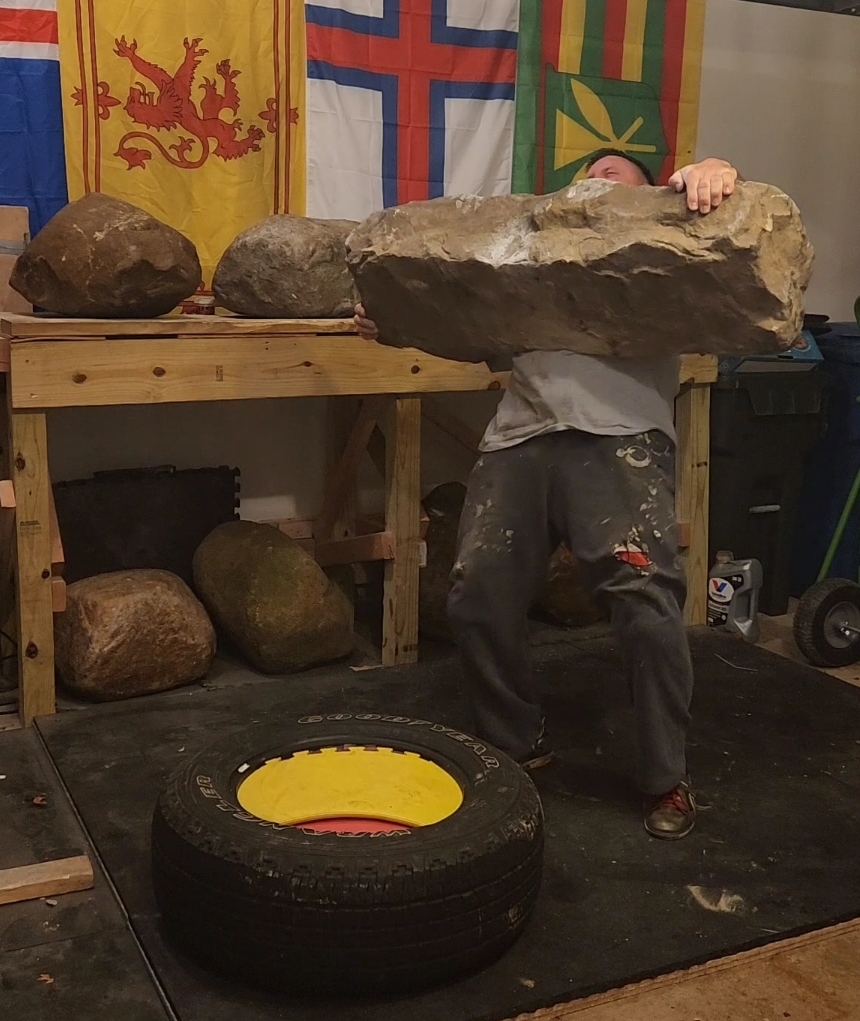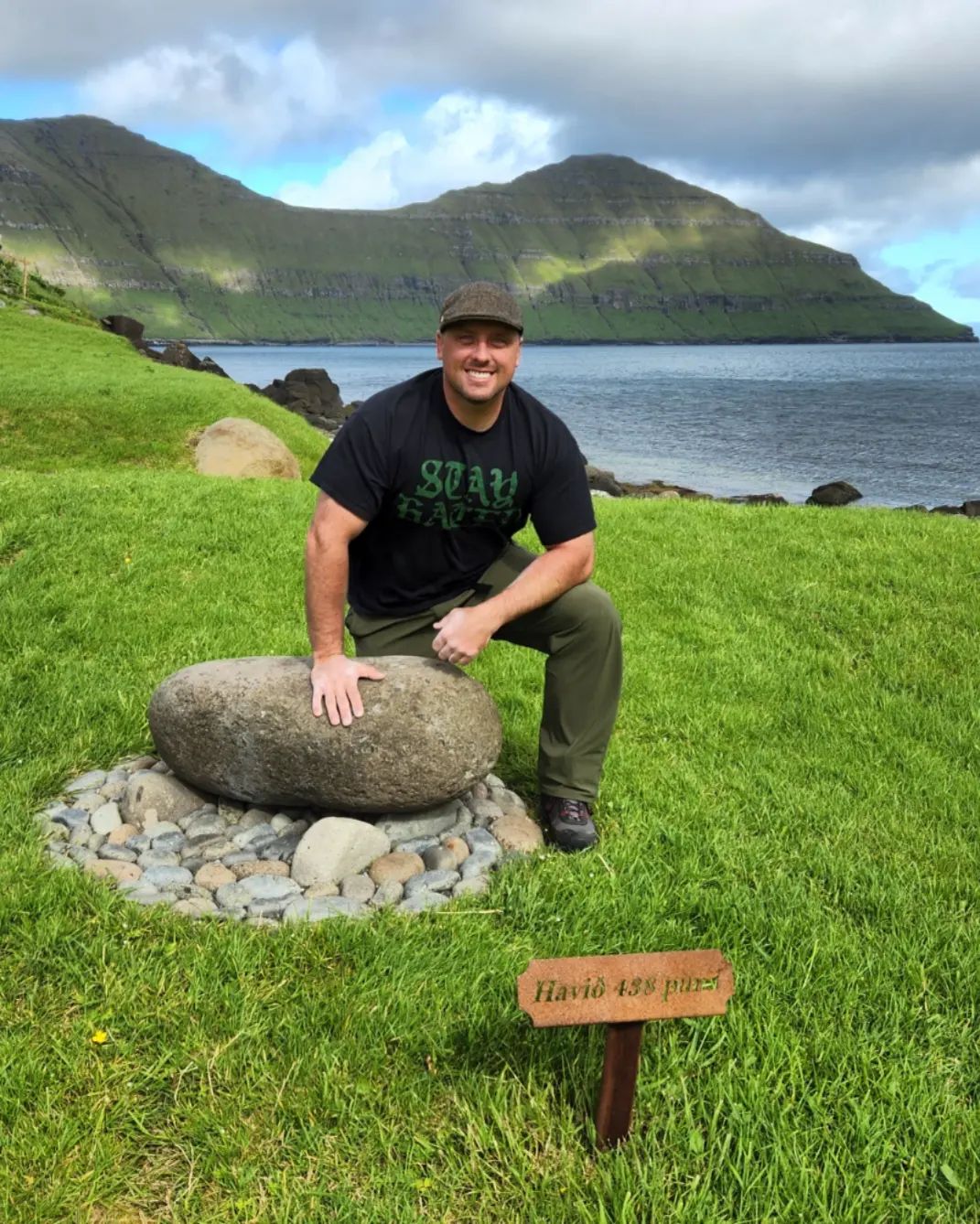Stonelifting training: Structure
Guest article by Sean Urquhart
Since my tour of the Faroe Islands, a number of people have asked me about how I structure my training for stonelifting and how I prepare for a stone tour. Everyone is different, but I have found what seems to work for me and I continue to make progress year after year — and I want to share that with you.
This is how I structure my stonelifting training. In part 2, I’ll go into more detail about what my workouts look like.
Alongside these articles, I’ve created a template for you to download and tweak as you like for your own stonelifting training.

How many days per week to train
I have had the best results training 4 days per week. However, I have also gotten great results from only 3 days per week when life is just too crazy. At first, I thought that I would get weaker or lose size only training 3 days per week, but it was the total opposite.
On 3 day weeks, I felt super fresh for each workout which allowed me to push harder than training 4 days per week. It also left me with extra time to spend with my family which is far more important than time spent training. It is important to find what works best for you based on your training preferences, work and life obligations, and experience.
When I structure my training, I like to make sure that I always have a day off before I lift stones or do lower body because those workouts are (obviously) the most important to me.
Take the template I created for you and tweak it anyway that you need. There are many times when life is just out of control. When that happens, I may take an extra day off or spend 2-3 workouts in a row doing speed work. I promise you that taking time off from heavy work to focus on speed/recovery will not hurt your gains. In fact, some of my biggest PRs in training have come after doing only speed work for the main lifts for 2 straight weeks. Your body will thank you.
In a 4 day week, I split my training into upper-body and lower-body days. And they’re split into heavy and speed days. So I’ll do lower-body speed, upper-body speed, a rest day, lower-body heavy, another rest day, upper-body heavy, and a final rest day before repeating.
3 day weeks still have lower-body and upper-body heavy days, but instead of 2 speed days for upper/lower, we change it into a full body day.
Training block structure
My typical lifting blocks are done over 4 weeks. Intensity and volume wave up and down throughout the block to build fatigue. Then the 4th week is a priming/testing week where I try to test one lift (either deadlift, goodmorning, or squat) and a few different stone lifts. If the block went well, I could expect a good test day here.
To manage fatigue, I will treat the final lower body day as a lighter speed day. The 2nd to last Heavy day will have percentages approaching 85-90% with accommodating resistance while the speed day directly preceding the testing day will be a day in which I am priming my body for the heavier loads to come. This priming day will have a reduction in overall volume and intensity. I do not consider this a deload as I am still training with the same intent and focus I would at any other time in the block.
Taking time off
Deload weeks are not taken unless necessary. In many cases, I let life dictate when I need a deload. If on a max effort day, I am feeling beat up and the weights feel extra heavy, that becomes a speed day. It doesn’t take the place of my next speed workout. I will just do two in a row. If I haven’t slept or eaten well, I will usually take the day off and continue with my regular scheduled workout the following day.
I feel that forcing your body to underperform due to a lack of nutrition or sleep is like taking two steps back and on step forward. There’s no need to worry if you get out your routine. The only thing that could possibly happen by taking an extra day off is that you are more recovered when you hit the gym the next time.
After a particularly long stone tour, I will stay out of the weight room completely for however long I feel fit. After my first tour of Scotland in which I lifted 12 total stones, I was back in the weight room within a week and competing in professional highland games that weekend.
After my third stone tour (Faroe Islands and Iceland) in which I lifted 34 total stones, I didn’t touch a weight or stone for almost three weeks. It wasn’t that my body didn’t want to, but I fell into quite a depression after that trip, something that I have battled and learned to manage for nearly 20 years.
Organizing each workout
Each workout is split into 5 categories. I find that doing any more than 5 exercises in a single workout is just too much. If you are really pushing things hard then you won’t be able to do more than 5 exercises anyways. If you can, then you need to lift with more intensity.
Lower Body categories
- Warm-up Accessory Lift
- To be used to bring up lagging muscle groups that aid in stone lifts (Glutes or Hamstrings)
- Main Lift
- A variation of the squat, deadlift, or goodmorning
- Stones
- Either a full lift, extension, pick, or carry
- Supplemental Lift
- A lift that will build your main lift
- Accessory Lift
- One lift that will bring up a lagging muscle group to aid in stone lifts
Upper Body categories
- Warm-up Accessory Lift
- To be used to bring up lagging muscle groups (Upper Back, Traps, Rear Delts)
- Main Lift
- A variation of the bench press or overhead press
- Horizontal Lats aka Rows
- A row variation (oftentimes this is the lift that I target with the most intensity on upper body days)
- Vertical Lats aka Chin-Ups
- A Chin-up or Lat Pulldown variation
- Core Lift
- One abdominal exercise - a strong core is essential to lifting big stones. This is not the time to go light
Like I’ve been saying, being flexible and understanding that you can adjust your training on a day-to-day basis is key. Listen to your body. But be honest with yourself and put the effort in!
Now that I’ve given you an overview of how I structure my training, read part 2 for detail about warm-ups, exercise selection, and adding stone lifts into my workouts.
Author
Sean Urquhart is one of the top stonelifting researchers and lifters in the world. In 2022, Sean toured the Faroe Islands, lifting more than 30 immensely heavy stones in just a couple of weeks.

Contributions
With massive thanks to Sean for sharing his expertise! You can follow him on Instagram.
Read the liftingstones.org letters
Join thousands of other stonelifters who read the world's most popular stonelifting newsletter.